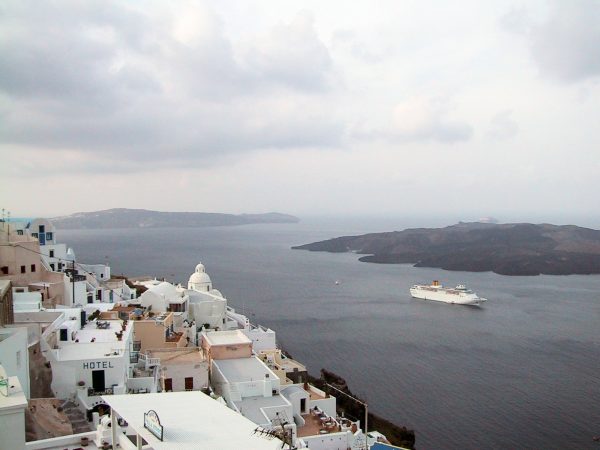 The caldera (crater) of Santorini is a result of one of the biggest volcanic eruptions in recorded history, over 3,500 years ago.
The caldera (crater) of Santorini is a result of one of the biggest volcanic eruptions in recorded history, over 3,500 years ago.
Rumor has it that the eruption wiped out the island civilization of Atlantis around 1450 BC. Whether this is true or not, we do know that the tsunami waves caused by the eruption wiped out Crete, almost 75 miles away.
From the airport we grabbed a cab to the Hotel Aigialos, a short walk from the town of Fira. The hotel is a group of very traditional cycladic houses overlooking the Caldera. It was cloudy and overcast on the day we arrived, but the view was spectacular.
In the late afternoon and the pack donkeys were heading back down the hill towards the cruise ship dock.
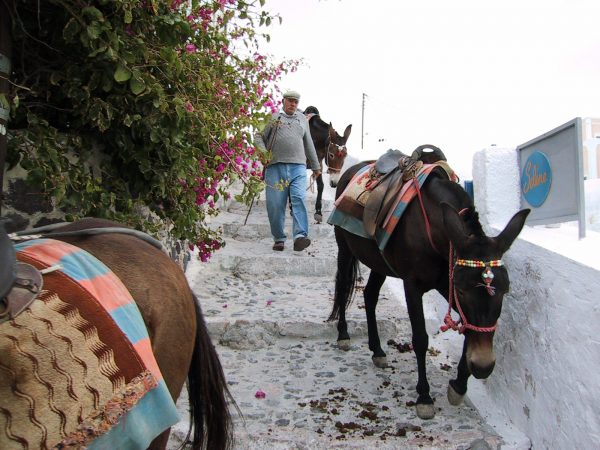
Our house was on the donkey path. For years these pack mules have been transporting people and their luggage from the cruise ships below to Fira. An elevator was installed a few years back but people still seem to prefer the donkeys, as long as you have the time. It’s a long walk up and down the stairs.
We also learned a new word, “indoxie”. It means it’s OK.
Our introduction to Santorini keftedes came at Naussa’s taverna. These are fried meatball-shaped treats made of tomatos, starch and onions, no meat. And they are delicious. We passed on the Greek wine. We haven’t been here long enough and my memories of college retsina hangovers were still fresh in my memory, even though they happened over 30 years ago.
After dinner it was a stroll through Fira; a labrynth of jewelry, t-shirts, cruise-ship patrons and the ever present spungi. I know we’re going to bring some of these sponges back home with us.
We rented a car on the advice of Santos (“No bikes, too windy”). He also counselled us not to read the rental contract, or he wouldn’t rent the car to us. “But what if we get into an accident?” I asked. “Not to worry”, he replied. “Everything is covered.” I had no idea what he meant but within 20 minutes we were off to Akrotiri, the local archeology dig; a huge covered site where treasures are pulled to the surface daily.
We convinced ourselves that the old city was related to Atlantis, the civiliation covered by the the volcano blast of 1450 BC. From the looks of the remains, most people were able to get out before the volcano blew. Very few valuable possesions were left behind and those that were found were taken to other museums.
From Akrotiri, we drove to Red Beach, named for the red sandstone of the mountain face. From there, on to Exomitis. We were told this was the the best-preversed example of a Byzantine fortress on the island. However, after a 3 hour tour, we finally discovered nothing was left. 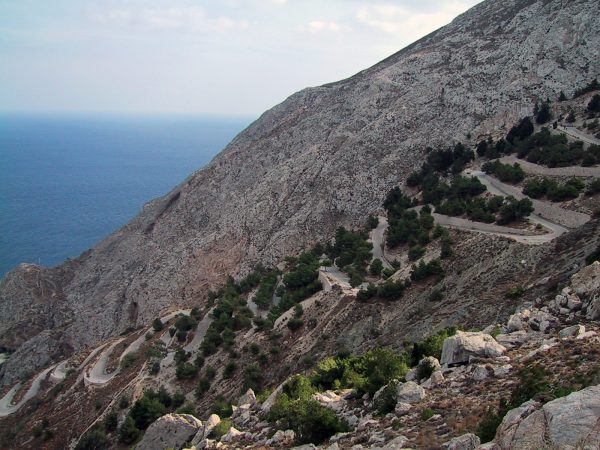 Well, it was an amazing climb to ancient Fira. We met an older (than us) couple from San Francisco who told us they had just climbed it. We accepted the challenge. Actually, by the look of the road, it was probably easier to climb than to take the car.
Well, it was an amazing climb to ancient Fira. We met an older (than us) couple from San Francisco who told us they had just climbed it. We accepted the challenge. Actually, by the look of the road, it was probably easier to climb than to take the car.
The city on the North side of the island is called Oia (pronounced ee-oh). We were told the town was haunted but we never knew how or why. It’s another beautiful cycladian town wih spectacular views of the Agean and the best place to see the sunset over the Caldera. We had made plans to return to Oia that night so we were scouting out how to get to the restaurant. Back in Mykonos we met Gary and Barbara from Minnesota. We stayed a the same hotel in Mykonos and flew together on the same flight to Santorini. We made plans to meet up for dinner that night.
On our way back to Fira we were stopped by an Orthodox priest. He didn’t even ask for a ride. He just opened the car door and got in. Once again we made small talk (very small talk) and dropped him off at the Monastery at Finikia. He blessed us with a large hammy hand before leaving the car.
Back to the hotel for an hour or so and then the long return to Oia for dinner with Gary and Barbara, Roy and Janie (the San Franciscans we met earlier at ancient Fira, a cat named Juliet and a couple of newly-weds who just had their passports stolen in Italy. Apparently they were with a tour and someone posing as the tour guide told everyone to hand her their passports and she would get them through customs. When they got to the customs window, there were no passports and no tour guide. They had an extra few days in Rome waiting for new ones to be issued.
We woke up to tthe sound of the mules going down the mountain to work. A pleasant way to start the day. It was a short drive to Parisa Beach but the weather was still uncooperative and so we decided to head up to Profitas Ilias (the old monastery) instead. The locals on Santorini get around by hitch-hiking rides from passing cars. There are buses but they don’t seem to run very often and all they have to do is stick out their hand and someone will stop. We were hi-jacked again, this time by Greek grandparents who flagged us down with all the authority of royals. We picked them up, spoke our 5 Greek phrases and at the appropriate stop, they tapped me on the shoulder and pointed they wanted to get out. And so they did. Words were exchanged but no one understood what they were. A perfect diplomatic conversation.
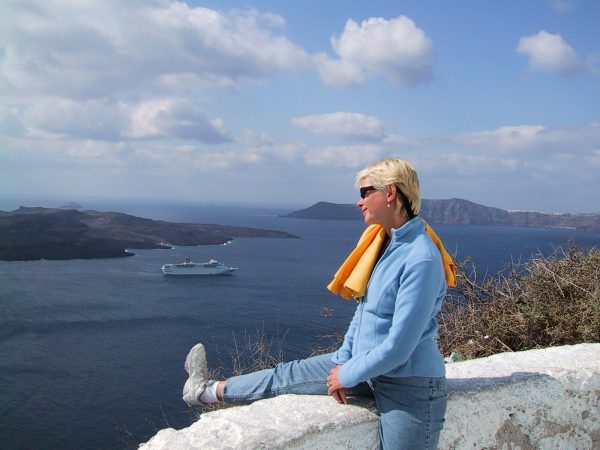
We had a final dinner at Nicholas’s Taberna. The fresh fish of the day depended on the language skills of your waiter. I ordered the sea bass. the Australian couple next to us ordered the red snapper. We both got the same fish.
The following morning we drove the car to the airport. Santos told us to park the car to the left of the terminal building and leave the key under the car mat. “it’s OK to leave the door unlocked?” I asked. “It’s OK”, he replied. “Everyone knows it’s my car.” And so we left the car and flew to Crete. We never heard anything else about it.
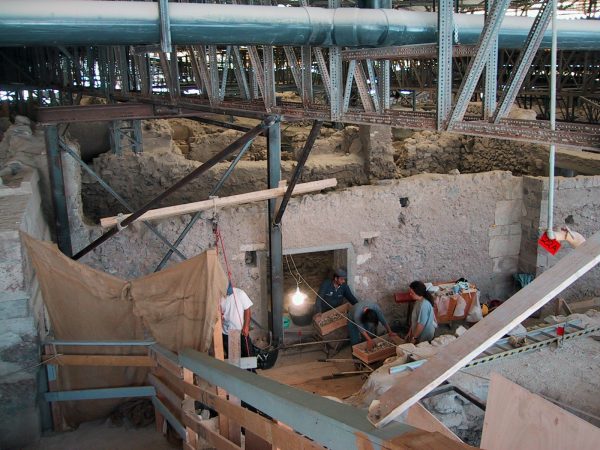
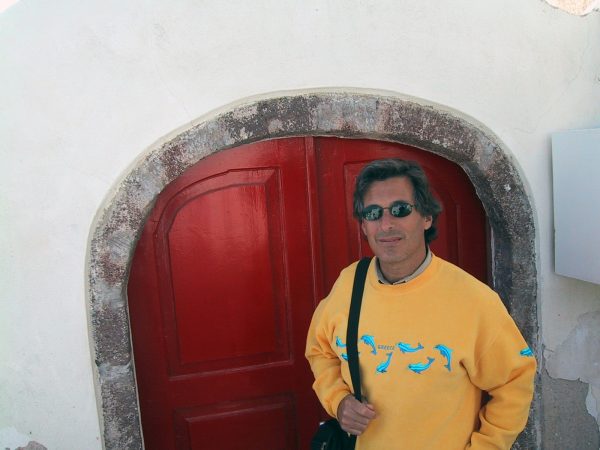
You must be logged in to post a comment.